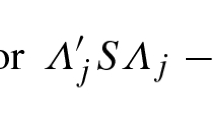Abstract
Classical factor analysis assumes a random sample of vectors of observations. For clustered vectors of observations, such as data for students from colleges, or individuals within households, it may be necessary to consider different within-group and between-group factor structures. Such a two-level model for factor analysis is defined, and formulas for a scoring algorithm for estimation with this model are derived. A simple noniterative method based on a decomposition of the total sums of squares and crossproducts is discussed. This method provides a suitable starting solution for the iterative algorithm, but it is also a very good approximation to the maximum likelihood solution. Extensions for higher levels of nesting are indicated. With judicious application of quasi-Newton methods, the amount of computation involved in the scoring algorithm is moderate even for complex problems; in particular, no inversion of matrices with large dimensions is involved. The methods are illustrated on two examples.
Similar content being viewed by others
References
Aitkin, M., & Longford, N. T. (1986). Statistical modeling issues in school effectiveness studies.Journal of the Royal Statistical Society, Series A 149, 419–461.
Cronbach, L. J. (1976).Research on classrooms and schools: Formulation of questions, design, and analysis. Unpublished manuscript, Stanford University, Stanford Evaluation Consortium, School of Education.
Crosswhite, F. J., Dossey, J. A., Swafford, J. O., McKnight, C. C., & Cooney, T. J. (1985).Second International Mathematics Study: Summary report for the United States. Champaign, IL: Stipes.
de Leeuw, J., & Kreft, I. (1986). Random coefficient models for multilevel analysis.Journal of Educational Statistics, 11, 57–85.
Goldstein, H. (1986). Multilevel mixed linear model analysis using iterative generalized least squares.Biometrika, 73, 43–56.
Goldstein, H. (1987).Multilevel models in educational and social research. London, U.K.: C. Griffin & Co.
Goldstein, H., & McDonald, R. P. (1988). A general model for the analysis of multilevel data.Psychometrika, 53, 455–467.
Härnquist, K. (1978). Primary mental abilities of collective and individual levels.Journal of Educational Psychology, 70, 706–716.
Harville, D. A. (1974). Bayesian inference for variance components using only error contrasts.Biometrika, 61, 383–385.
Jamshidian, M., & Jennrich, R. I. (1988).Conjugate gradient methods in confirmatory factor analysis (UCLA Statistics Series 8). Los Angeles: UCLA.
Jennrich, R. I., & Schluchter, M. D. (1986). Unbalanced repeated-measures models with structured covariance matrices.Biometrics, 42, 805–820.
Jöreskog, K. G. (1977). Factor analysis by least-squares and maximum-likelihood methods. In K. Enstein, A. Ralston, & H. S. Wilf (Eds.),Statistical methods for digital computers (pp. 125–153). New York: John Wiley & Sons.
Jöreskog, K. G., & Sörbom, D. (1979).Advances in factor analysis and structural equation models. Cambridge, MA: Abt Books.
Lawley, D. N., & Maxwell, A. E. (1971).Factor analysis as a statistical method (2nd ed.). London: Butterworth & Co.
Lee, S. Y. (1990). Multilevel analysis of structural equation models.Biometrika, 772, 763–772.
Lee, S. Y., & Jennrich, R. I. (1979). A study of algorithms for covariance structure analysis with specific comparisons using factor analysis.Psychometrika, 43, 99–113.
Longford, N. T. (1987). A fast scoring algorithm for maximum likelihood estimation in unbalanced mixed models with nested random effects.Biometrika, 74, 817–827.
Longford, N. T. (1988).VARCL. Software for variance component analysis of data with hierarchically nested random effects (maximum likelihood). Princeton, NJ: Educational Testing Service.
Longford, N. T. (1990). Multivariate variance component analysis: An application in test development.Journal of Educational Statistics, 15, 91–112.
Luenberger, D. G. (1984).Linear and nonlinear programming (2nd ed.). Reading, MA: Addison-Wesley.
Mason, W. M., Wong, G. Y., & Entwisle, B. (1984). Contextual analysis through the multilevel linear model. In S. Leinhardt (Ed.),Sociological methodology (1983–84) (pp. 72–103). San Francisco: Jossey Bass.
McDonald, R. P., & Goldstein, H. (1989). Balanced versus unbalanced designs for linear structural relations in two-level data.British Journal Mathematical and Statistical Psychology, 42, 215–232.
Muthén, B. O. (1989). Latent variable modeling in heterogeneous populations.Psychometrika, 54, 557–585.
Muthén, B. O. (1991). Multilevel factor analysis of class and student achievement components.Journal of Educational Measurement, 28, 338–354.
Muthén, B. O. (in press). Mean and covariance structure analysis of hierarchical data.Journal of Educational Statistics.
Muthén, B. O., & Satorra, A. (1989). Multilevel aspects of varying parameters in structural models. In R. D. Bock (Ed.),Multilevel analysis of educational data (pp. 87–99). New York: Academic Press.
Patterson, H. D., & Thompson, R. (1971). Recovery of interblock information when block sizes are unequal.Biometrika, 58, 545–554.
Raudenbush, S. W., & Bryk, A. S. (1985). A hierarchical model for studying school effects.Sociology of Education, 59, 1–17.
Author information
Authors and Affiliations
Additional information
Suggestions and corrections of three anonymous referees and of an Associate Editor are acknowledged. Discussions with Bob Jennrich on computational aspects were very helpful. Most of research leading to this paper was carried out while the first author was a visiting associate professor at the University of California, Los Angeles.
Rights and permissions
About this article
Cite this article
Longford, N.T., Muthén, B.O. Factor analysis for clustered observations. Psychometrika 57, 581–597 (1992). https://doi.org/10.1007/BF02294421
Received:
Revised:
Issue Date:
DOI: https://doi.org/10.1007/BF02294421




